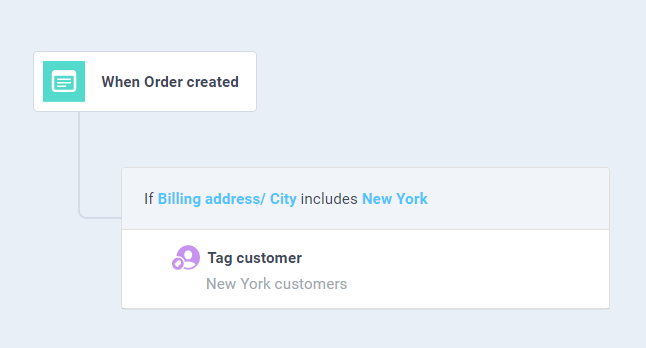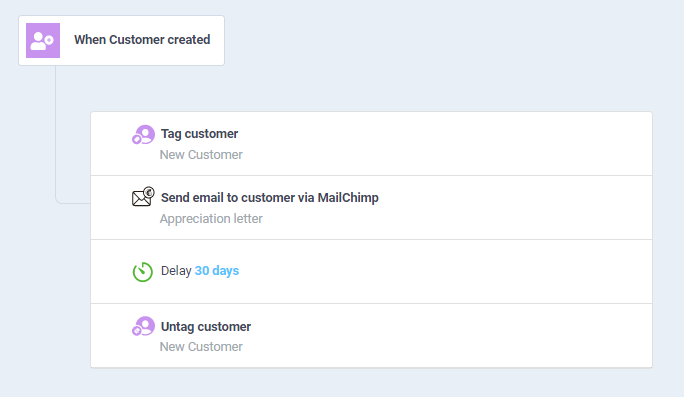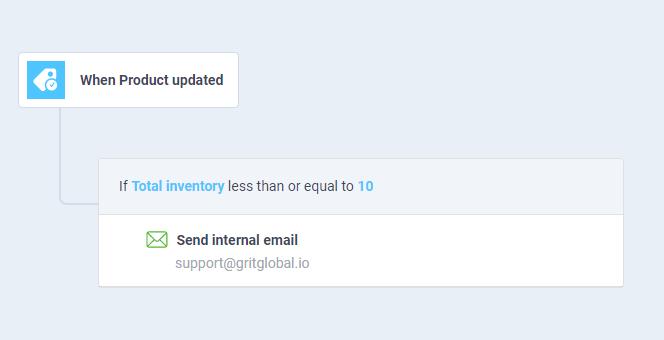Companies everywhere are embracing automation technology to transform their tedious manual tasks into streamlined procedures that are executed when needed.
This is because eCommerce workflow automation has been extremely effective for businesses of all sizes. Its benefits include reduced operational cost, increased productivity, limited human error, and time-saving.
Automated workflows are in fact a chain of If-then order:
- If the customer places an order, assign them to this group
If the remaining stock reaches a certain number, send an alert to staff about the out-of-stock item
Each company has different business goals, thereby has different ways of utilizing eCommerce workflow automation. However, there are 5 must-know examples of workflow automation that every business should take into account if you want to bring your productivity to another level.
1. Customer segmentation based on location
Customer segmentation is the practice of dividing your audience into subgroups based on particular criteria. For example, a customer who purchases more than 10 times on your store can be considered a loyal customer and should be treated with special promotion programs.
Having clear and coherent workflow automation of customer segmentation helps minimize human error and possess more accurate categorization. It also allows for tailored campaigns with a personal target.
If you’re operating in more than one location, it is imperative to segment your customer relative to their shipping address. This type of information will help you understand their needs and deliver area-specific ads. It is also useful when targeting a broad area as it enables you to customize the message according to regional differences in languages, norms, interests, the amount of money they’re willing to spend, etc.
TRIGGER: When an order is created
CONDITION: If the billing address includes New York
ACTION: Tag this customer as “New York customer”

2. Sending a welcome letter
A welcome email is the first mutual interaction a customer has with your brand after showing interest in your product. With the customer’s information attached in the letter, the open rate can reach 84.22%, without providing any irrelevant information other than a confirmation of their subscription.
The email should be sent out immediately after the visitor submits a signup form for your newsletter. Usually, retailers use an automated workflow that integrates your store with email marketing tools like Mailchimp or Klaviyo to make sure they don’t miss out on any chance to say thank you and generate a good impression.
CONDITION: When a new customer is created
TRIGGER: If they complete signing up for the subscription form
ACTION: Then tag the customer as “new customer” and send a welcome letter via MailChimp
DELAY: Wait for 30 days
Action: Then untag this customer as “new customer”

3. Abandoned cart reminder
The global figure for abandoned shopping carts was almost 70% in 2020. People may leave your store without completing an order for multiple reasons such as complicated payment processes, low loading speed, unsatisfied choice, etc. While it is highly crucial that you fix all the technical issues in the first place, a good abandoned cart program will keep the customer engaged and save a decent amount of order.
A reminder email should be sent approximately one hour after the visitor leaves your site. You can also identify if this is an existing customer or a first comer to your website to tailor information accordingly.
Examples of eCommerce workflow automation to remind of abandoned cart should be:
CONDITION: When an order is fulfilled
TRIGGER: If the payment status is pending
DELAY: Wait for 1 hour
ACTION: Then send the customer a reminder

4. Automatically publish a product
Holidays and other special occasion is always great opportunity to boost your revenue. The American household spending during the Christmas holiday season 2019 peaked at $1,496. All of those purchases totaled more than $1.1 trillion, deemed as one of the biggest shopping periods ever recorded
It is likely that you’ll have to update your special offer for holidays and notify your customers about it. Though highly potential, it is frustrating having to pay attention to launching every item at a time. To get rid of this, you can set up workflow automation that publishes products when the day comes and unpublish them once the holiday season is over. You can save time using similar workflow automation examples on any occasion other than just holiday seasons.
CONDITION: When a new product is created in the store
DELAY: Wait for 24 hours (for the holiday to start)
ACTION: Publish the product
DELAY: Wait for 2 days (for the holiday to end)
ACTION: Unpublish the product

5. Low stock alert
One of the worst scenarios of being a merchant is being unable to provide the customer with the desired products. You might risk not only losing tons of orders but also long-term consequences. Customers will turn to another store and continue choosing it if they have a satisfying experience.
To save yourself from encountering this issue, you can set up an automated workflow as examples below that sends your team a notification when the stock reaches a certain level. This way, you have time to reorder items in time. Some advanced applications even manage to deliver a notification letter to the customer when the stock is refilled.
CONDITION: When there is a product update
TRIGGER: If the total inventory is less than or equal than 10
ACTION: Then send an email to internal staff warning about a low-stock item

As a retailer, you have a lot of competition. The more choices customers have, the more likely they are to leave you if the shopping experience is not up to their expectations. To seize your position in the market, you must get your business process to run smoothly. That’s why workflow automation is something you can’t afford to miss.
Apart from these 5 must-know workflow automation examples, there are many others you can use to reduce tedious manual tasks. The key is to take time to evaluate your business and figure out which repetitive tasks need altering for better productivity. In order to seamlessly streamline your store, you need to use the right software. If you’re running on Shopify, check out Ergo Automation and give it a try.








